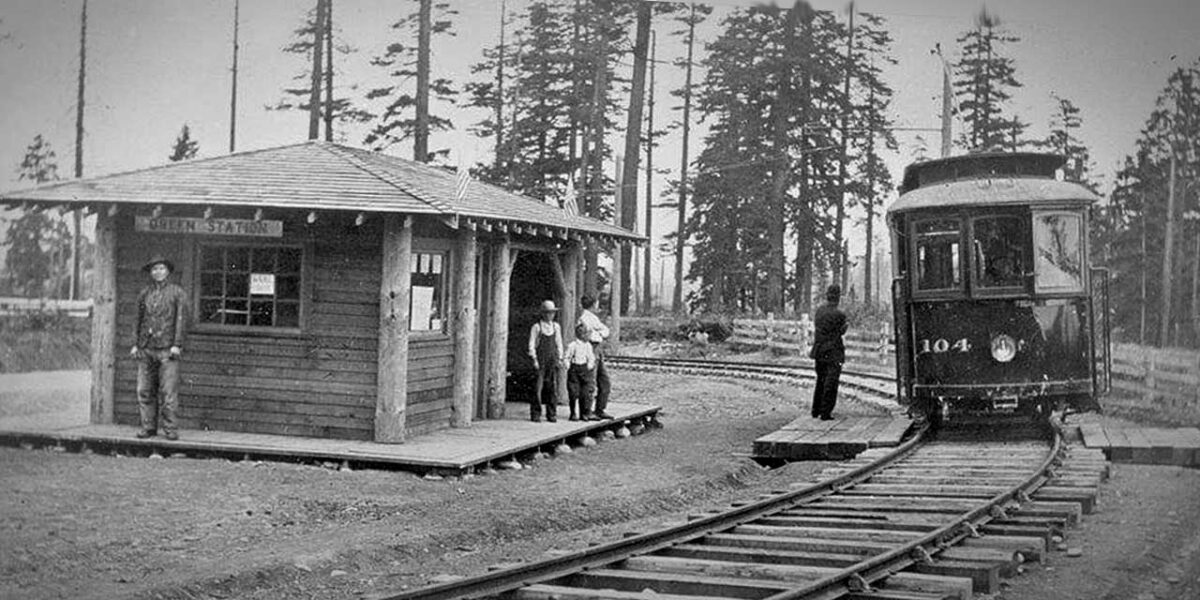The squeak and rumble of streetcars soaring down their tracks may have been a daily sound in Seattle, but at the turn of the century, the Highline area was largely isolated from the sources of commerce in the surrounding areas.
Communities on the geographic “high line” were difficult to access and there was a dearth of roads leading out of the Highline area and into more developed regions, most notably the City of Seattle.
A group of nine capitalists – including George White, for whom current-day White Center is named – saw this need and set to work. Hiring a contractor, engineer, and land surveyor, these investors created the Highland Park & Lake Burien Railroad, which ran from SW 152nd Street in Seahurst all the way to Spokane Street in Seattle. There it connected to a pre-existing line that ran straight into Downtown Seattle.
Mike Bergman, President of the Tacoma Chapter of the National Railway Historical Society and author of the book “Seattle’s Streetcar Era” told us how the creation of the Highland Park & Lake Burien Railroad shaped the development of the area.
“Most streetcar lines were not called railroads, but the founders of the line had a vision to not only haul passengers, but also lumber and building supplies to build homes and businesses, which really impacted the development of the Burien and White Center business districts,” Bergman said.

Dangerous Caterpillars
While the shiny new line may have facilitated a growth boom for Burien, it wasn’t without its hiccups. A portion of the line ran through a heavily forested area on a steep grade. Swarms of caterpillars made their homes in the trees, frequently dropping on the line causing the streetcars to lose traction and come to a standstill until the track could be cleared. This was especially a problem for the cars carrying freight, as they were much heavier and unable to climb the steep grade while slipping and sliding all over the track.
Falling caterpillars were not the only danger to the line – in 1912, the same section of track prone to onslaughts of caterpillars suffered a landslide that covered about a mile of track between Highland Park and Spokane Street. With the line out of commission, the original founders were unable to pay their contractor, and subsequently, ownership of the Highland Park & Lake Burien Railroad was granted to the contractor in lieu of payment in bankruptcy court.
Now the owner of a line that needed extensive repairs to be operational and no desire to be in the streetcar business, the contractor approached the Seattle City Council and offered them ownership of the line free of charge in exchange for them repairing the line and making it operational once more. The city agreed, and after extensive repairs spanning 18 months, the Highland Park & Lake Burien Railroad line re-opened in 1914, bringing in a transportation Golden Age for Highland Park and Burien.
By the late 1920s, the city ran in to considerable difficulty keeping the railroad open. Due to the emergence of roads and the increasing use of private automobiles, streetcar ridership was dipping dramatically, and freight delivery was switching to trucks. After a failed attempt at raising fares to cover costs, the city began closing sections of the line. The first to go? The section that serviced White Center and Burien south of Seattle city limits.
In 1933, another landslide closed the line. The General Manager wanted to repair the line, but in the end, it was closed and the streetcars were replaced by buses.
“When the 1933 slide happened, a streetcar on the southern end of the line at Roxbury Street was stranded and had no way to get back to its car barn. So, the municipal railway decided to leave it there as a shelter. When the buses started, you could wait in the old streetcar,” Bergman said.
The Pacific Northwest Railroad Archive is a non-profit organization located at 425 SW 153rd Street in Burien (map below), and dedicated to the preservation of the history of PNW railroads and the incredible impact they have had on developing the country as we know it today.
You can learn more about the archive on their website.


